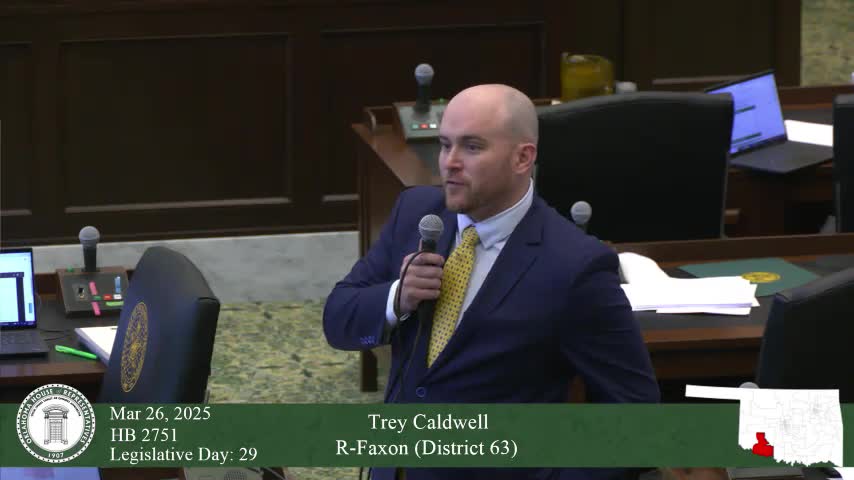Oklahoma House passes strict wind energy regulations with House Bill 2751
March 26, 2025 | 2025 Legislature OK, Oklahoma
This article was created by AI summarizing key points discussed. AI makes mistakes, so for full details and context, please refer to the video of the full meeting. Please report any errors so we can fix them. Report an error »

A pivotal discussion on wind energy regulations unfolded during the Oklahoma House of Representatives meeting on March 26, 2025, as lawmakers debated House Bill 2751. The bill, aimed at establishing a statewide regulatory framework for wind energy, sparked intense debate over its implications for local economies and property rights.
Representative Caldwell, the bill's author, emphasized that the legislation does not ban wind turbines but instead promotes responsible development by requiring consensus among local stakeholders before new turbine farms can be established. He highlighted the economic benefits of wind energy, noting that Pushmataha County, one of the poorest in the state, received $1 million in property taxes from existing wind turbines.
However, opposition voices raised concerns about the potential negative impacts of the bill. Critics argued that the new regulations could stifle investment in wind energy, which has been a significant source of revenue and jobs in rural areas. Representative Deck warned that the bill sends a message against future investments in wind energy, potentially harming local economies that rely on these projects.
Supporters of the bill, including Representative Chapman, argued that the legislation introduces necessary oversight to an industry that has operated with minimal regulation. They believe that the proposed standards will protect property rights while ensuring safety and environmental considerations are addressed.
The debate also touched on broader themes of energy policy in Oklahoma, with some representatives advocating for a balanced approach that includes all forms of energy production, including oil and gas. The discussion highlighted the tension between promoting renewable energy and protecting traditional energy sectors.
Ultimately, the House passed the bill with a vote of 68 to 22, signaling a significant step in shaping Oklahoma's energy landscape. As the bill moves to the Senate, its future will depend on continued advocacy from both supporters and opponents, reflecting the ongoing struggle to balance economic growth with environmental and community concerns.
Representative Caldwell, the bill's author, emphasized that the legislation does not ban wind turbines but instead promotes responsible development by requiring consensus among local stakeholders before new turbine farms can be established. He highlighted the economic benefits of wind energy, noting that Pushmataha County, one of the poorest in the state, received $1 million in property taxes from existing wind turbines.
However, opposition voices raised concerns about the potential negative impacts of the bill. Critics argued that the new regulations could stifle investment in wind energy, which has been a significant source of revenue and jobs in rural areas. Representative Deck warned that the bill sends a message against future investments in wind energy, potentially harming local economies that rely on these projects.
Supporters of the bill, including Representative Chapman, argued that the legislation introduces necessary oversight to an industry that has operated with minimal regulation. They believe that the proposed standards will protect property rights while ensuring safety and environmental considerations are addressed.
The debate also touched on broader themes of energy policy in Oklahoma, with some representatives advocating for a balanced approach that includes all forms of energy production, including oil and gas. The discussion highlighted the tension between promoting renewable energy and protecting traditional energy sectors.
Ultimately, the House passed the bill with a vote of 68 to 22, signaling a significant step in shaping Oklahoma's energy landscape. As the bill moves to the Senate, its future will depend on continued advocacy from both supporters and opponents, reflecting the ongoing struggle to balance economic growth with environmental and community concerns.
View full meeting
This article is based on a recent meeting—watch the full video and explore the complete transcript for deeper insights into the discussion.
View full meeting
